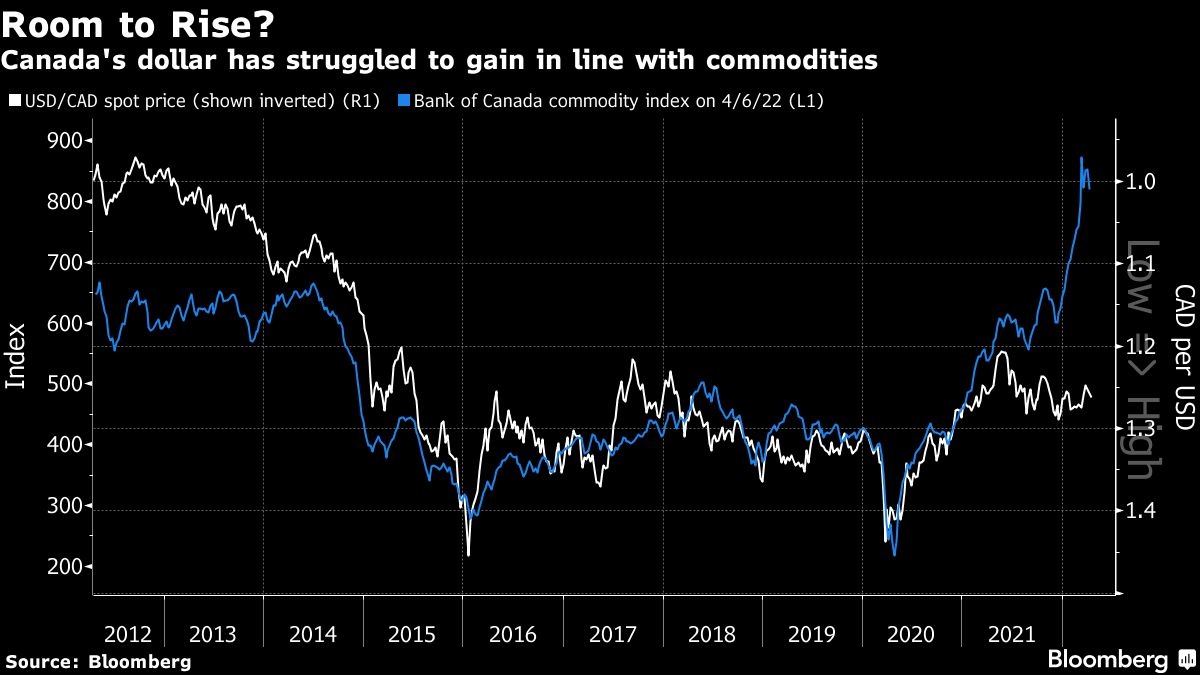Apr 12, 2022
Traders eye BoC as possible catalyst for Canadian dollar catchup
, Bloomberg News
Raising interest rates have no impact on rate of inflation: Economist
Canada’s dollar has scope to make up ground against some of its biggest commodity-related peers if the country’s central bank provides an appropriate shot of hawkishness this week.
While the currency has received some support from higher oil and resource prices in the wake of the Russia-Ukraine war, it has lagged the likes of the Australian dollar and the Norwegian krone, and some analysts reckon that the so-called loonie remains unduly weak. This Wednesday’s Bank of Canada meeting, which is widely expected to deliver a half-point interest rate hike, could well prove a catalyst for fresh moves higher.
“The Canadian dollar is still undervalued, so at some point that should adjust,” said Brad Bechtel, a strategist at Jefferies LLC. He predicts that the currency will rally as the BOC “continues to become more and more hawkish.”

The market has shown some signs of increased positivity over the past month, with the currency up close to 1 per cent against its U.S. counterpart. Short-term option skews have become less bearish for the loonie, while futures market positioning data last week showed leveraged funds shifting to their least negative stance since mid-February.
The Canadian dollar gained as much as 0.4 per cent intraday Tuesday to 1.2582 per greenback after slower than expected core U.S. consumer price inflation data.
Ahead of this week’s key decision, some observers have begun to bolster their projections for where they see the local currency ending this year, with Barclays Plc predicting it will go to about $1.22 per U.S. dollar from Tuesday levels of around $1.26.
Expectations for what the Bank of Canada might choose to do on monetary policy have climbed sharply along with the recent ramp up in rhetoric south of the border at the Federal Reserve. A half-point increase at this week’s BOC meeting is seen as close to certain, and the market is now pricing in more than 2 percentage points of hikes by the end of 2022. But inflation concerns globally remain in flux and all eyes will be on BOC Governor Tiff Macklem for further signs of perceived hawkishness.
But with that certainty comes risk if the central bank instead implements a quarter-point increase. The scope of the negative impact on the loonie from such a move would “largely depend on the bank’s forward guidance,” Scotiabank strategists Shaun Osborne and Juan Manuel Herrera said in a note on Tuesday.
If a “smaller-than-expected hike is not accompanied by a change in language that clearly tees up large hikes over the next few meetings, then the CAD may suffer losses above the 1.28 level over the coming days or weeks,” they said.
Bank of America Corp. sees Macklem implementing a “potentially brisk” pace of tightening which would provide “persistent support” to the Canadian dollar in the months ahead, according to a note from analysts Carlos Capistran and Ben Randol.
Other potential tailwinds for the Canadian dollar include the fact that it’s relatively far away geographically from the ongoing war in Ukraine and its comparatively muted response so far to higher commodity prices -- at least when lined up versus its counterparts in Norway and Australia.
Against the big dollar, though, the picture is perhaps more uncertain. With war fears still intermittently driving haven flows and a Federal Reserve that’s seemingly ever-more-hawkish, the obstacle of the mighty greenback remains a large one to overcome.
This dynamic is evident in the U.S.-Canadian dollar options market. One-week risk reversals -- a measure of positioning and sentiment that incorporates the timing of this week’s BOC gathering -- have become less bullish for the greenback. But those at the one-month tenor -- which cover the next Fed meeting -- are distinctly more greenback positive.

